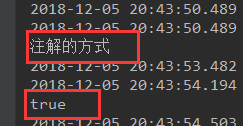3springboot:springboot配置檔案(配置檔案、YAML、屬性檔案值注入<@Value、@ConfigurationProperties、@PropertySource,@ImportResource、@Bean>)
1.配置檔案:
springboot預設使用一個全域性配置檔案 配置檔名是固定的配置檔案有兩種(開頭均是application,主要是檔案的字尾):
->application. properties ->application. yml
作用:修改springboot自動配置的預設值
springboot在底層把一切都自動配好
位置:
配置檔案放在src/main/resourcr目錄或者 類路徑/config 下
2.YAML:
YAML(YAML Ain't Markup Language)
YAML A Markup Language:是一個標記語言
YAML isn't Markup Language:不是一個標記語言;
標記語言:
以前的配置檔案;大多都使用的是 xxxx.xml檔案;
YAML:以資料為中心,比json、xml等更適合做配置檔案;
該語法風格:
server: port: 8088
使用語法:
k:(空格)v:表示一對鍵值對(空格必須有);
以空格的縮排來控制層級關係;只要是左對齊的一列資料,都是同一個層級的
值的寫法:
字面量:普通的值(數字,字串,布林)
k: v:字面直接來寫;
字串預設不用加上單引號或者雙引號;
" ":雙引號;不會轉義字串裡面的特殊字元;特殊字元會作為本身想表示的意思
name: "zhangsan \n lisi":輸出;zhangsan 換行 lisi
' ':單引號;會轉義特殊字元,特殊字元最終只是一個普通的字串資料
name: ‘zhangsan \n
1.物件、Map(屬性和值)(鍵值對):
注意空格
Person: name:xxxx age:12
行內寫法:
Person: {name:xxx,age=12
2.陣列(List、Set):
用-(空格) 值表示陣列中的一個元素
gender:
-(空格) boy
-(空格) gril
行內寫法
gender: [gril,boy]
匯入配置檔案處理器,配置檔案進行繫結就會有提示
<dependency>
<groupId>org.springframework.boot</groupId>
<artifactId>spring-boot-configuration-processor</artifactId>
<optional>true</optional>
</dependency>
3.程式碼測試

//將配置檔案中的每一個屬性的值對映到這個元件中 //告訴springboot將本類中的所有屬性和配置檔案中的相關配置進行繫結 //(prefix = "person")將配置檔案中以person下的所有屬性進行繫結 @Component @ConfigurationProperties(prefix = "person") public class Person { private String name; private Integer age; private boolean boss;//布林值 private Date bir;//時間 private Map<String,Object> map;//Map private List<String> lists;//List private Dog dog;//物件 }
public class Dog { private String name; private Integer age; }
在yml配置檔案中
person: name: Mr age: 14 boss: true bir: 2018/12/21 map: {m1: v1,m2: v2} lists: - mc - mt dog: name: dogdog age: 10
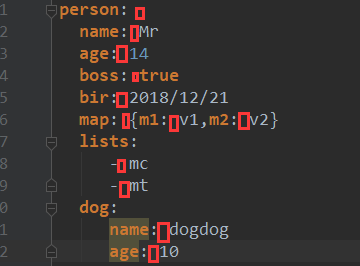
測試:
@RunWith(SpringRunner.class) @SpringBootTest public class Springboot01ApplicationTests { @Autowired Person person; @Test public void contextLoads() { System.out.println(person); } }
Person{name='Mr', age=14, boss=true, bir=Fri Dec 21 00:00:00 CST 2018, map={m1=v1, m2=v2},
lists=[mc, mt], dog=Dog{name='dogdog', age=10}}
使用properties字尾的:
person.name=mr person.age=22 person.bir=2018/12/11 person.boss=true person.map.q1=1 person.map.q2=2 person.lists=a,b,c person.dog.name=cat person.dog.age=22

關於亂碼的問題:
properties配置檔案在idea中預設utf-8可能會亂碼
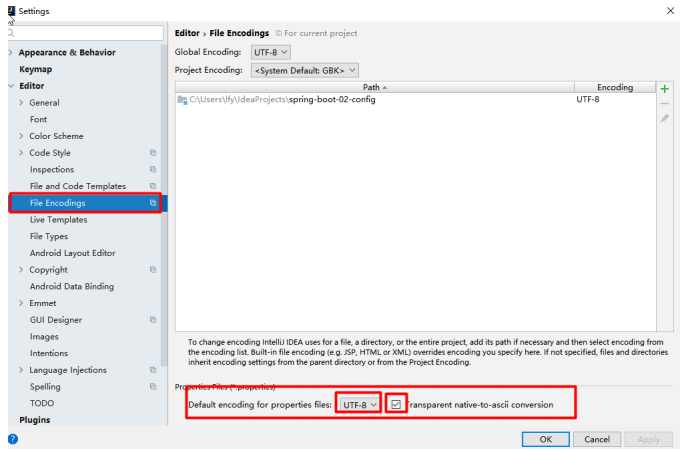
4.配置檔案值注入@Value
@Value:1.字面量 2.#{spel} 3.${key}從環境變數配置檔案中取值
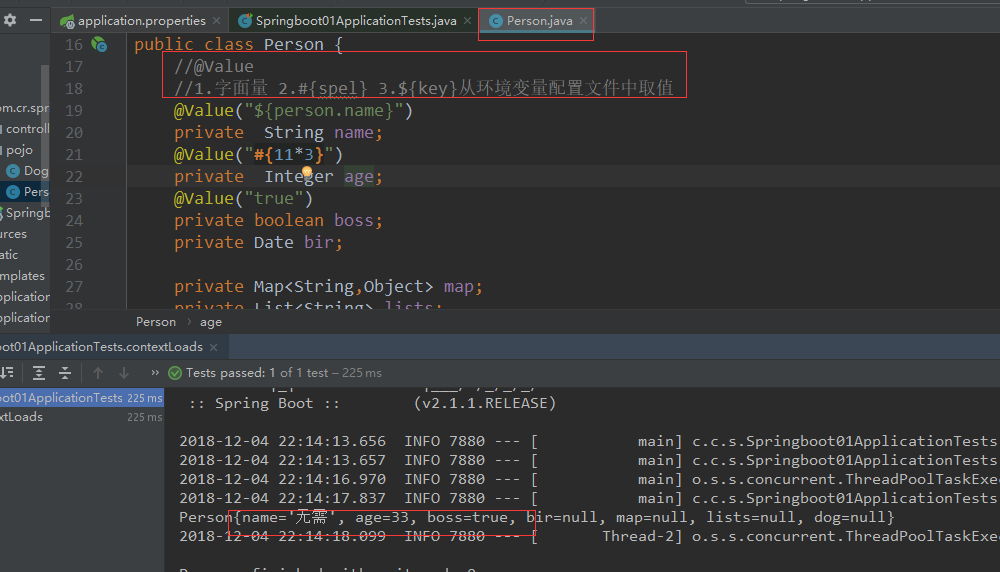
@Value獲取值和@ConfigurationProperties獲取值比較
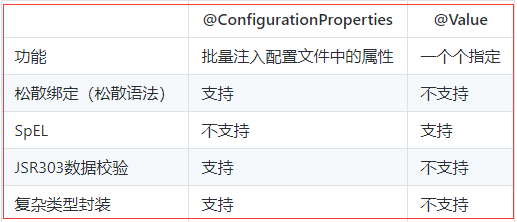
鬆散語法繫結:last_name = last-name = lastName 他們取的值都是相同的
配置檔案yml還是properties他們都能獲取到值;
如果說,我們只是在某個業務邏輯中需要獲取一下配置檔案中的某項值,使用@Value;
如果說,我們專門編寫了一個javaBean來和配置檔案進行對映,我們就直接使用@ConfigurationProperties;
資料校驗:
@Component @ConfigurationProperties(prefix = "person") @Validated public class Person { @Email private String name; ... }
獲取配置檔案中的某個值:
@ResponseBody @Controller public class Helloword { @Value("${person.name}") private String name; @RequestMapping("/hello") public String hello(){ return "Hello tow!" + name; } }
[email protected],@ImportResource
@PropertySource: 載入指定的配置檔案@PropertySource(value = {"classpath:/person.properties"})
@Component
@ConfigurationProperties(prefix = "person")
public class Person {
private String name;
private Integer age;
private boolean boss;
private Date bir;
...
}


@ImportResource
@ImportResource:匯入Spring的配置檔案,讓配置檔案裡面的內容生效;
Spring Boot裡面沒有Spring的配置檔案,我們自己編寫的配置檔案,也不能自動識別;
想讓Spring的配置檔案生效,載入進來;@ImportResource標註在一個配置類上
@ImportResource(locations = {"classpath:spring.xml"}) @SpringBootApplication public class Springboot01Application { public static void main(String[] args) { SpringApplication.run(Springboot01Application.class, args); } }
public class helloword { public void hello(){ System.out.println("hello"); } }

<?xml version="1.0" encoding="UTF-8"?> <beans xmlns="http://www.springframework.org/schema/beans" xmlns:xsi="http://www.w3.org/2001/XMLSchema-instance" xsi:schemaLocation="http://www.springframework.org/schema/beans http://www.springframework.org/schema/beans/spring-beans.xsd"> <bean id="hello" class="com.cr.springboot01.ImportSoource.helloword"></bean> </beans>
@Autowired ApplicationContext app; @Test public void testImportSourcr(){ boolean h = app.containsBean("hello"); System.out.println(h); }

@Bean
全註解方式:
新建一個配置類
//配置類,指明當前類使配置類,代替xml配置檔案 @Configuration public class MyConfig { //將方法的返回值新增到容器中,容器中這個元件預設的id就是方法名 @Bean public Helloword hello(){ System.out.println("註解的方式"); return new Helloword(); } }
@Autowired ApplicationContext app; @Test public void testImportSourcr(){ boolean h = app.containsBean("hello"); System.out.println(h); }
